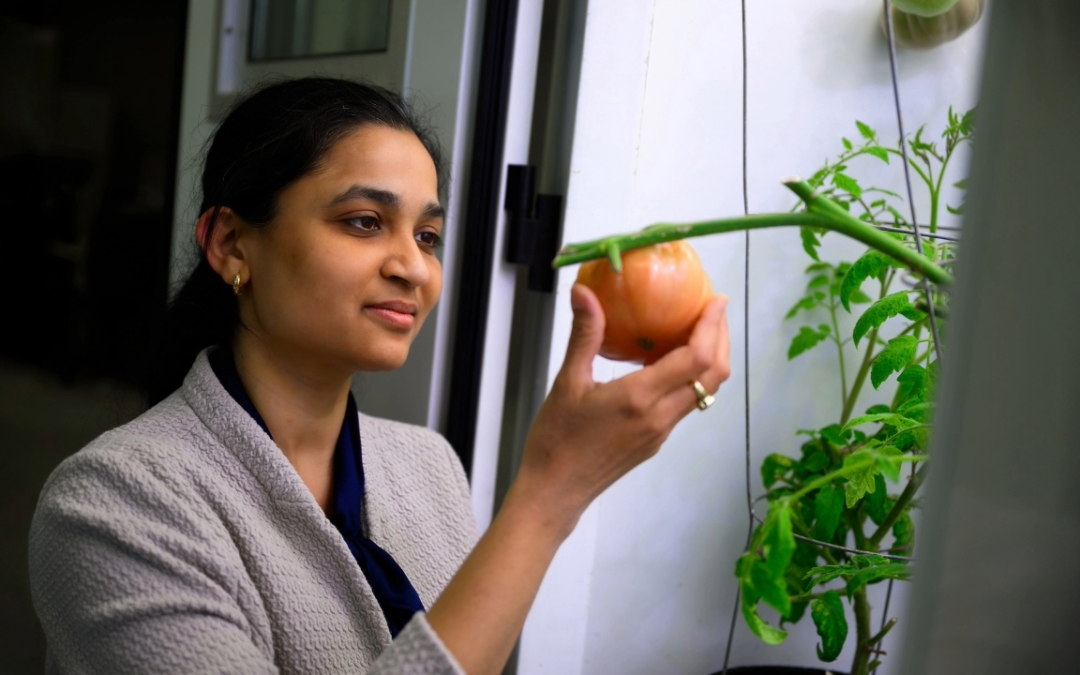
Extension Agronomist Tyler Sandlin explains crops research during the recent open house tour held at the Tennessee Valley Research and Extension Center in Belle Mina, Ala.
by PAUL HOLLIS
North Alabama legislators and agricultural leaders got an update on the 2016 growing season and a review of some of the latest crop research during an open house tour at the Tennessee Valley Research and Extension Center in July.
“It’s been a mixed bag as far as weather conditions,” Tyler Sandlin, extension agronomist for north Alabama, told the visitors. “Some areas have received timely showers, but we’ve received roughly 5 inches of rain here at the station. When crops are in the reproductive stage and using 3/10 inch of water per day, it doesn’t always equal out.”
In row-crop projects at the center, several varieties of cotton were being grown in a product evaluation test to help growers manage or control reniform nematodes.
“Nematodes feed on the plant root, obstructing the root system and nutrient flow,” Sandlin said. “This can impact yield. Our tests are looking at products to help remedy or control reniform nematodes in cotton.”
Reniform nematodes can be especially troublesome in cotton that is grown continuously in a rotation, Sandlin said, but not all growers have the luxury of being able to grow other crops.
“Some farmers are locked into a continuous cotton rotation, whether it’s a landowner or lease-type situation,” he said. “This test is designed to test products that are available to help these producers.”
Another test is looking at a herbicide product’s effect on soybeans.
“We have a herbicide in our arsenal that’s great for resistant marestail,” Sandlin said. “However, some soybean varieties are sensitive to that product. It can stunt, injure and impact yield to some degree.”
Each variety may perform differently, he said, so 64 soybean varieties were screened against the herbicide for tolerance and susceptibility.
“We then distributed that information to growers to help them make better management decisions on their farms,” Sandlin said. “Companies perform similar screenings, but we are the only source for unbiased data.”
The cotton variety test at TVREC consists of 21 cultivars, two of which are commercially available and are being used as the standard check.
“We know those two varieties have excellent yield and good fiber quality—everything a producer would want,” Sandlin said. “The other 19 varieties are not commercially available, and we’re evaluating them to see how they perform.”
The new varieties contain three traits that make them tolerant to three herbicides that control different weeds, primarily Palmer amaranth pigweed.
“Quite honestly, we’re losing the battle in some fields to herbicide-resistant weeds, so these products are needed,” Sandlin said. “But in addition to having those three traits, cotton needs to yield well and fiber quality must be excellent.”
Another focus of crops research in the Tennessee Valley is irrigation efficiency, he said.
“Irrigation helps to mitigate risks in farming, but how do we better schedule when we water crops?” Sandlin asked. “Do we go out and kick the dirt and guess if we need to water?”
One way farmers can conserve water is by using soil moisture sensors. The sensors being used at the center transmit data every four hours, showing the soil’s profile.
“We can measure active rooting depth,” he said. “We also can trigger the timing of irrigation applications in our crops, helping us conserve water resources and make better yields.”
Cotton thrips management
Managing cotton thrips is an annual concern of producers, and researchers at TVREC are using a 14-treatment experiment to evaluate seed treatments, in-furrow sprays, in-furrow granules and combinations of those control methods.
“Thrips and plant bugs are two of the major insect pests farmers see each year in the northern part of the state, and farmers need help making management decisions,” said Tim Reed, extension entomologist. “We’re also seeing resistance to thrips insecticide seed treatments, and that’s a major concern.”
Thrips have been collected from throughout the state, and this resistance has been documented, Reed said.
“We’re also worried about losing seed treatments for the perceived and alleged impact they may be having on honey bees,” he said. “We need data from this study to show EPA that we need that product.”
Once cotton gets past the fourth or fifth true leaf stage, it’s no longer susceptible to thrips damage, Reed said.
“Consultants tell farmers not to spray moderate levels of thrips damage because the treatment may flare other insects,” he said. “I’m willing to tolerate a moderate amount of damage, because it doesn’t make a difference with yield. On the other hand, if you have severe damage, it’ll kill your stand.”
Research conducted in the Tennessee Valley, Prattville and Headland have shown that insecticide seed treatments are a good investment.
“They’ll give you two to three weeks of protection, and then you’ll have to use a foliar spray if cotton isn’t growing off rapidly and has several true leaves on it,” he said.
Another project that could potentially pay dividends to Alabama farmers is a statewide pheromone tracking program for the key moths that lay eggs in soybeans and cotton.
“We have picked up a tremendous amount of moths this year, as have people in Arkansas and North Carolina,” Reed said. “We’ve seen huge numbers of cotton bollworm moths and soybean loopers in the south and central parts of the state, and we’re alerting farmers about these numbers.”
Trapping also is being done for the Old World Bollworm, a difficult-to-control pest in the rest of the world.
“We’re doing DNA testing to determine if we have this species. If we do get this pest, it will cross with cotton bollworm and produce a hybrid that will be difficult to control.”




